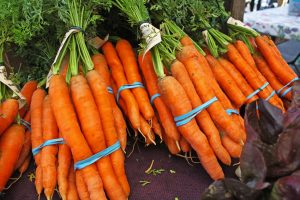Elimination Diet: Guide to Getting Started
My body has been on a rollercoaster ride these past six months. For more than four of them, I wasn’t sleeping, I was constantly irritable and exhausted, and I had terrible acid and bile reflux (more on that here). My gastrointestinal system was basically leading a revolt against the rest of my body. After multiple visits to multiple doctors and several medical exams including an endoscopy, one of my doctors finally put me on an elimination diet.
And guess what. It changed everything.
If you’re experiencing any gastrointestinal issues or simply want to give your body a thorough cleanse and detox, my vote goes to the elimination diet. Here’s the scoop.
What is an elimination diet?
The elimination diet is designed to clear your body of foods and chemicals to which you may have a reaction and improve your body’s ability to handle and dispose of those substances. The program can also help reduce inflammation and act as a reset button for your entire system. It’s essentially a detox that allows your body to start functioning efficiently again.
Why is it called an elimination diet?
When you follow the program to a T, you’re eliminating certain foods from your diet, usually for three to four weeks. If your symptoms improve during this period, you’ll carefully add foods back into your diet one at a time to see which ones may be triggering reactions.
What can I expect when doing the elimination diet?
There’s no “normal” response to an elimination diet — everyone responds differently. Many people find they have more energy, increased mental alertness, decreased muscle and joint pain, and an overall sense of improved well-being. That said, it often takes time for the body to adjust. In the first several days, you might experience changes in sleep patterns, lightheadedness, headaches, joint or muscle stiffness, and changes in gastrointestinal function.
What can I eat on an elimination diet?
I’ve re-created a chart my doctors shared with me as I embarked on my own program. The chart lists out foods to include and exclude. You should also avoid any “included” foods you already know give you trouble (e.g. for me, onions, garlic and spicy seasonings like cayenne and paprika).
| Fruits: whole fruits, unsweetened frozen fruits, canned fruits, diluted juices | Citrus (oranges, lemons, limes, grapefruit, etc.) and citrus juices |
| Vegetables: all raw, steamed, sautéed, juiced or roasted vegetables | Corn, nightshades (peppers, tomatoes, eggplant, potatoes, goji) |
| Animal Proteins: organic chicken, turkey, lamb, and duck; fresh or water-packed canned fish; wild game | Beef, veal, pork, sausage, canned meats, cold cuts, hot dogs, shellfish |
| Non-Gluten Grains and Starch: rice, quinoa, oats (if gluten-free), buckwheat, millet, amaranth, teff, tapioca | Grains: wheat, barley, rye, corn, spelt, kamut, triticale |
| Vegetable Protein: legumes (beans, lentils, peas), protein powders made from hemp, pea, and rice | Soybean products (soy sauce, soybean oil in processed foods, soy milk, soy yogurt, tofu, tempeh, etc.) |
| Nuts and Seeds: almonds, brazil nuts, cashews, coconut, hazelnuts, pecans, pine nuts, pumpkin seeds, sesame seeds, sunflower seeds, walnuts, nut butters (e.g. almond or cashew butters) | Peanuts and peanut butter |
| Dairy Substitutes: nut milks (almond milk, coconut milk), rice milk, oat milk | Milk, all cheeses, all yogurts, butter, cream, ice cream, eggs and egg products (e.g. mayonnaise), foods prepared with eggs |
| Oils: cold pressed oils, including olive, canola, sunflower, safflower, sesame, almond, flax, pumpkin seed, walnut | Butter, margarine, shortening, processed oils, store-bought salad dressings |
| Drinks: filtered or distilled water, decaffeinated herbal teas (without citrus), seltzer or mineral water | Alcohol, coffee and other caffeinated beverages, soda and soft drinks |
| Sweeteners: agave nectar, brown rice syrup, blackstrap molasses fruit sweetener, stevia | Refined sugar (white and brown), honey, maple syrup, high fructose corn syrup, evaporated cane juice |
| Condiments: all spices | BBQ sauce, ketchup, chutney, relish, steak sauce, teriyaki, etc. |
| Chocolate |
If you’re thinking OH MY GOSH, how am I ever going to do this? Don’t worry — I thought the same thing six weeks ago. But it’s totally doable. And between my menus and recipes and the rest of the Internet, you’ll be able to get through it and you’ll feel a million times better.
How on earth can I give up…
- Pasta? Quinoa and rice pastas can actually be pretty tasty when done right!
- Ice cream? Ugh, a toughie. But I’m a huge fan of coconut ice cream. My favorite brand is Coconut Bliss. Their Vanilla is great, especially with some dark cherry balsamic vinaigrette and crushed pecans on top. I found this at Whole Foods, Lucky, and my local organic market. Note – don’t go overboard here. Even with their trimmed down ingredient lists, they’re still processed foods that often contain additives like guar gum, which some folks have a negative reaction to.
- Peanut butter? Okay, this might be controversial, but almond butter is arguably better. And there are a ton of other nut butters to choose from, too.
- Crackers and chips? I’ll give it to you — this one was tough. But then I discovered Beanitos and went to town on their delicious bean chips. My favorite was Black Bean. (Like the coconut ice cream above, go light on these – they’re still processed even with their trimmed down ingredient lists.)
- Going out to eat or meeting up with friends for drinks? To be honest, as a twenty-something living in a major city, this was the most frustrating thing about the diet. Instead of lamenting my lame social life, though, I invited friends over for dinner and cooked them healthy, delicious meals I could eat. Plus, think of all the money you’ll save on restaurants and booze!
Okay, but I need more tips to make it through this thing!
You’ve got it. Here are some of the tips I found helpful from my doctor and from the lovely Interwebs.
- This is not a calorie-restricted plan! You’re not trying to lose weight. You’re giving your body time to heal. Eat when you’re hungry, and if you find yourself losing weight like I did, incorporate more rice and legumes into your meals as you go.
- Drink a LOT of water! At least 64 ounces (two quarts) a day.
 Take it easy. Seriously. Get a LOT of rest and relaxation. Take some time to binge-watch Netflix without the guilt. Avoid super strenuous workouts so that your body can heal more effectively without the additional burden imposed by exercise.
Take it easy. Seriously. Get a LOT of rest and relaxation. Take some time to binge-watch Netflix without the guilt. Avoid super strenuous workouts so that your body can heal more effectively without the additional burden imposed by exercise.- Plan out an entire week’s worth of meals on the weekend and take care of as much grocery shopping and cooking as you can before you take on the work week. This will make it easier to stay on-plan.
- Make big meals once or twice a week, and freeze some along the way. Voilà! Easy grab-and-go leftovers for lunch and dinner.
- Choose fresh, organic produce wherever possible to avoid eating the pesticides and other chemicals that plague our agricultural system.
- Choose free-range, organically raised animal proteins and wild-caught, cold-water fish.
- Read food labels very carefully. Corn, wheat, soy, and sugar make their way into an awful lot of foods.
- I found sushi to be the best option for dining out while on this diet. Fish (but not shellfish) and rice, no soy sauce. Still delicious!
- Caffeine junkie and not sure how you’re going to give it up? Start slowly — reduce your intake day by day to avoid withdrawal.
- Vegetarian? Eliminate the meats and fish and replace with more rice, beans, and non-gluten grains.
But wait! How do I reintroduce foods?
I’m working on writing the reintroduction post as we speak! (Update: here’s my guide to reintroducing challenge foods on the elimination diet.)
One more thing! Can I have sample menus, grocery lists, and recipes?
You bet. I’ll be writing and sharing those over the next few weeks, too. (Update: here are all of my elimination diet-friendly recipes thus far. Always more to come!)
17 Comments
Comments are closed.



[…] This is the second post in a two-part series about the elimination diet. The getting started guide explains the first three to four weeks of the program, in which you’re completely […]
[…] on earth was I going to stick to the elimination diet while on the road for eight days with several other people? Would I have seven sleepless, acid-y […]
[…] This berry banana smoothie is a powerhouse of protein and antioxidants. It’s my go-to elimination diet-friendly breakfast recipe. It revs up my metabolism first thing in the morning, fills me up, and […]
[…] and hit the spot when I was in the mood for a warm, somewhat sweet dinner. It’s also an elimination diet-friendly recipe. Here’s how to make […]
[…] became well acquainted with this dynamic duo while I was on the elimination diet since it was delicious and easy on the stomach. Here’s the […]
[…] like most of the smoothies I publish here on my blog, it’s super easy to make and it’s elimination diet-friendly. Here’s how to do […]
[…] dear readers, keep an eye out in the coming weeks for a detailed outline of the elimination diet, a guide to reintroducing challenge foods, and a bunch of delicious, elimination diet-friendly […]
[…] recipe with you because chicken breasts and I became well acquainted while I was on the elimination diet. Oh, and because I have a serious thing for roasted carrots and parsnips this […]
[…] of chicken soup can’t hurt. At all. Plus, it’s delicious and comforting. And elimination diet-friendly. So here’s how to throw one […]
[…] I actually dug into the details (which you can find here in my guide to getting started on the elimination diet), I realized there were plenty of options for well-rounded, healthy and filling meals on the […]
I have a slight allergy to raw almonds. I’d be willing to drink almond milk or almond butter in small doses but usually I go for soy milk? Do you think soy products are good diary substitutes?
Hi Katherine! Soy milk actually has quite a bit of protein and potassium, making it a solid substitute. I’d recommend buying organic (and therefore non-GMO, as soy is one of the most common genetically modified crops) and unsweetened (read: no added sugar). The fewer ingredients listed on the bottle/carton, the better!
Could I try lactose free milk and stuff in place of the dairy? Or is lactose not the only problem with dairy?
Also, how picky do I need to be with ingredients on labels? (I’m known to go overboard on “rules” if I’m not careful.)
What protein powder is safe to use on the Elimination diet in a smoothie?
Hi Kathy, I’m not terribly familiar with protein powders to be honest, but I’d look into brown rice, hemp and/or pea-based ones. In general, you’ll want to do a thorough reading of the nutrition label, as a lot of protein powders have added sugars, flavors, and other ingredients that aren’t elimination diet-friendly. Good luck!
You have gluten free oats listed on the ‘include foods’ list, then also have them as a group to reintroduce..?
I’m so happy I stumbled on this blog. I’m currently dealing with the worst bout of acid reflux symptoms (nauseous and vomiting, hooray!) I’ve had to date – and I’ve been dealing with issues for years. I’ve recently started looking into an elimination diet and some have been so restrictive I question how I’ll survive considering nothing I’d read correlated to what I’m dealing with.
Thank you so much for this guide!